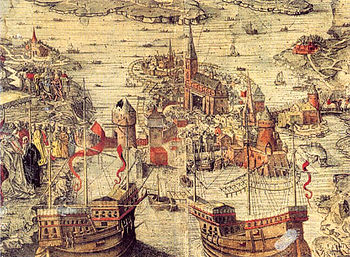
Back حمام دم ستوكهولم ARZ Stokholm qətliamı Azerbaijani Стакгольмская крывавая лазня Byelorussian Стокхолмска кървава баня Bulgarian Bany de sang d'Estocolm Catalan Stockholmská krvavá lázeň Czech Det Stockholmske Blodbad Danish Stockholmer Blutbad German Stokholma sangobano Esperanto Baño de sangre de Estocolmo Spanish

The Stockholm Bloodbath (Swedish: Stockholms blodbad) was a trial that led to a series of executions in Stockholm between 7 and 9 November 1520. The event is also known as the Stockholm massacre.[1]
The events occurred after the coronation of Christian II as the new king of Sweden,[2] when guests in the crowning party were invited to a meeting at Tre Kronor castle. Archbishop Gustav Trolle, demanding economic compensation for things such as the demolition of Almarestäket's fortress, questioned whether the former Swedish regent Sten Sture the Younger and his supporters had been guilty of heresy. Supported by canon law, nearly 100 people[3] were executed in the days following the meeting despite promises of amnesty. Among those killed were many people from the aristocracy who had been supporting the Sture Party in the previous years. Thereafter King Christian II became known in Sweden as Kristian Tyrann ("Christian [the] Tyrant").
- ^ Usually called "Stockholm bloodbath" (natively Stockholms blodbad), the event is also known as "Stockholm massacre" in English, so called in the English translation of Erik Gustaf Geijer's Svenska folkets historia (1832–36), published in 1845 as The History of the Swedes (p. 102).
- ^ Lindqvist 1993, p. 13
- ^ Stockholm Bloodbath on Nationalencyklopedin's website. Retrieved 8 January 2014.